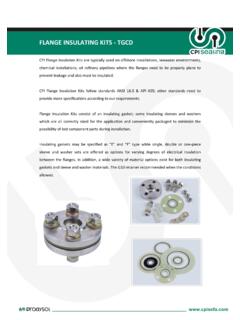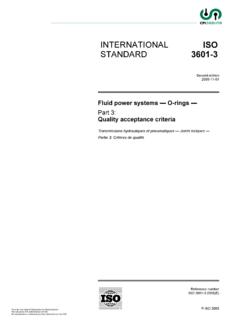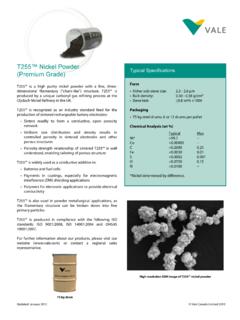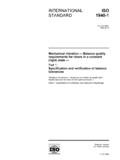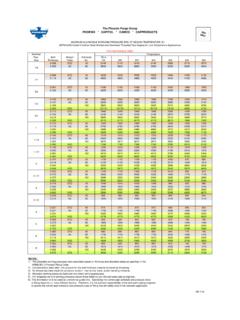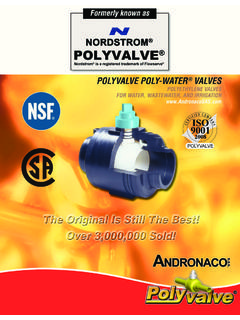Transcription of INTERNATIONAL STANDARD 3601-3
1 Reference numberISO 3601-3 :2005(E) ISO 2005 INTERNATIONAL STANDARD ISO3601-3 Secon d edition2005-11-01 Fluid power systems O-rings Part 3: Quality acceptance criteria Transmissions hydrauliques et pneumatiques J oints toriques Partie 3: Crit res de qualit Copyright INTERNATIONAL Organization for Standardization Reproduced by IHS under license with ISO No reproduction or networking permitted without license from IHS ISO 3601-3 :2005(E) PDF disclaimer This PDF file may contain embedded typefaces. In accordance with Adobe's licensing policy, this file may be printed or viewed but shall not be edited unless the typefaces which are embedded are licensed to and installed on the computer performing the editing. In downloading this file, parties accept therein the responsibility of not infringing Adobe's licensing policy. The ISO Central Secretariat accepts no liability in this area. Adobe is a trademark of Adobe Systems Incorporated.
2 Details of the software products used to create this PDF file can be found in the General Info relative to the file; the PDF-creation parameters were optimized for printing. Every care has been taken to ensure that the file is suitable for use by ISO member bodies. In the unlikely event that a problem relating to it is found, please inform the Central Secretariat at the address given below. ISO 2005 All rights reserved. Unless otherwise specified, no part of this publication may be reproduced or utilized in any form or by any means, electronic or mechanical, including photocopying and microfilm, without permission in writing from either ISO at the address below or ISO's member body in the country of the requester. ISO copyright office Case postale 56 CH-1211 Geneva 20 Tel. + 41 22 749 01 11 Fax + 41 22 749 09 47 E-mail Web Published in Switzerland ii ISO 2005 All rights reserved Copyright INTERNATIONAL Organization for Standardization Reproduced by IHS under license with ISO No reproduction or networking permitted without license from IHSISO 3601-3 :2005(E) ISO 2005 All rights reserved iiiContents Page iv Introduction.
3 Iv 1 Scope .. 1 2 Normative references .. 1 3 Terms, definitions and 1 4 3 Grade N (general purpose).. 3 Grade S (special).. 3 Grade CS (critical service).. 3 Selection of 3 5 Surface 3 6 Identification statement (reference to this part of ISO 3601).. 4 Copyright INTERNATIONAL Organization for Standardization Reproduced by IHS under license with ISO No reproduction or networking permitted without license from IHSISO 3601-3 :2005(E) ISO 2005 All rights reserved Foreword ISO (the INTERNATIONAL Organization for Standardization) is a worldwide federation of national standards bodies (ISO member bodies). The work of preparing INTERNATIONAL Standards is normally carried out through ISO technical committees. Each member body interested in a subject for which a technical committee has been established has the right to be represented on that committee.
4 INTERNATIONAL organizations, governmental and non-governmental, in liaison with ISO, also take part in the work. ISO collaborates closely with the INTERNATIONAL Electrotechnical Commission (IEC) on all matters of electrotechnical standardization. INTERNATIONAL Standards are drafted in accordance with the rules given in the ISO/IEC Directives, Part 2. The main task of technical committees is to prepare INTERNATIONAL Standards. Draft INTERNATIONAL Standards adopted by the technical committees are circulated to the member bodies for voting. Publication as an INTERNATIONAL STANDARD requires approval by at least 75 % of the member bodies casting a vote. Attention is drawn to the possibility that some of the elements of this document may be the subject of patent rights. ISO shall not be held responsible for identifying any or all such patent rights. ISO 3601-3 was prepared jointly by Technical Committee ISO/TC 20, Aircraft and space vehicles, Subcommittee SC 10, Aerospace fluid systems and components, and by Technical Committee ISO/TC 131, Fluid power systems, Subcommittee SC 7, Sealing devices.
5 This second edition cancels and replaces the first edition (ISO 3601-3 :1987), which has been technically revised. ISO 3601 consists of the following parts, under the general title Fluid power systems O-rings: Part 1: Inside diameters, cross-sections, tolerances and size identification code Part 3: Quality acceptance criteria Part 5: Suitability of elastomeric materials for industrial applications The following parts are in preparation: Part 2: Housing dimensions for general applications Part 4: Anti-extrusion devices (back-up rings) Copyright INTERNATIONAL Organization for Standardization Reproduced by IHS under license with ISO No reproduction or networking permitted without license from IHSI ntroduction In fluid power systems, power is transmitted and controlled through a fluid (liquid or gas) under pressure within an enclosed circuit. Components must be designed to meet these requirements under varying conditions.
6 Testing of components to meet performance requirement provides users a basis of assurance for determining design application and for checking component compliance with their stated requirements. ivINTERNATIONAL STANDARD ISO 3601-3 :2005(E) ISO 2005 All rights reserved 1 Fluid power systems O-rings Part 3: Quality acceptance criteria 1 Scope This part of ISO 3601 lays down the quality acceptance criteria of O-rings used in fluid systems, the dimensions of which are standardized in ISO 3601-1, ISO 16031-1 and ISO 16031-2. This part of ISO 3601 also defines and classifies surface imperfections on O-rings and specifies maximum acceptable limits for these imperfections. This part of ISO 3601 is also applicable to O-rings to be used in aerospace construction. 2 Normative references The following referenced documents are indispensable for the application of this document. For dated references, only the edition cited applies.
7 For undated references, the latest edition of the referenced document (including any amendments) applies. ISO 3601-1, Fluid power systems O-rings Part 1: Inside diameters, cross-sections, tolerances and size identification code ISO 5598, Fluid power systems and components Vocabulary ISO 16031-1, Aerospace fluid systems O-rings, inch series: Inside diameters and cross sections, tolerances and size-identification codes Part 1: Close tolerances for hydraulic systems ISO 16031-2, Aerospace fluid systems O-rings, inch series: Inside diameters and cross sections, tolerances and size-identification codes Part 2: STANDARD tolerances for non-hydraulic systems 3 Terms, definitions and symbols For the purposes of this document, the terms and definitions given in ISO 5598 and the following apply. backrind longitudinal imperfection in which the rubber adjacent to the flash line shrinks below the level of the moulding and has a U -like or W -like cross section with the flash frequently being ragged or torn [see Figure 1] combined flash combination of offset, flash and parting line projection Copyright INTERNATIONAL Organization for Standardization Reproduced by IHS under license with ISO No reproduction or networking permitted without license from IHSISO 3601-3 .
8 2005(E) 2 ISO 2005 All rights reserved inside diameter d1 O-ring inside diameter cross-section diameter d2 O-ring cross-section diameter excessive trimming flattened and often roughened area around the inner and/or outer diameters of an O-ring caused by the trimming process [see Figures 2a and 2b] flash film-like material that extends from the parting line projection or inner and/or outer diameters, caused by mould separation or present due to inadequate trimming [see Figure 3] flow mark thread-like recess, usually curved, of very slight depth in the unflexed state, with normal surface texture and round edge, caused by incomplete flow and knit of the material [see Figure 4] foreign material any extraneous matter embedded in the surface of the O-ring, contamination, dirt, etc. indentation depression, usually irregular in form, caused by the removal of inclusions from the surface or the build-up of hardened deposits on the surface of the mould cavity [see Figure 5] mismatch cross-sectional radius in one ring half being unequal to that of the other half, caused by dimensional difference in mould halves non-fill randomly spaced, irregularly shaped surface indentation having a coarser texture than the normal O-ring surface, caused by incomplete filling of, and or the trapping of air in, the mould cavity [see Figure 6] off-register misalignment of O-ring halves, caused by the lateral shift of one mould cavity plate relative to other Copyright INTERNATIONAL Organization for Standardization Reproduced by IHS under license with ISO No reproduction or networking permitted without license from IHSISO 3601-3 .
9 2005(E) ISO 2005 All rights reserved offset mismatch and/or off-register of O-ring halves [see Figure 7] parting-line indentation shallow saucer-like recess sometimes triangular in shape, located on the parting line at the inner and/or outer diameters, caused by deformation of the mould edge at the parting line parting-line projection continuous ridge of material situated at the parting line of inner and/or outer diameters caused by worn or excessively rounded edges of the mould cavity 4 Grades Grade N (general purpose) Grade N (general purpose) identifies acceptance criteria for O-rings intended for general use. See Table 1. Grade S (special) Grade S (special) identifies acceptance criteria for O-rings intended for applications requiring a higher level of quality and/or precision with respect to dimensional tolerances of surface imperfections. For example, aerospace or critical industrial or automotive applications are covered by this grade.
10 See Table 2. Grade CS (critical service) This grade identifies acceptance criteria for O-rings intended for applications requiring a much higher level of quality and/or precision with respect to dimensional tolerances of surface imperfections. For example, critical service aerospace or medical applications, where the surface of the O-ring must be near-perfect to perform in a satisfactory manner, are covered by this grade. See Table 3. Selection of grade If the user does not specify the grade at the time of purchase, Grade N will be assumed to be the quality requirement, except for specific aerospace applications where Grade S will be assumed to be the quality requirement. 5 Surface condition The O-ring surfaces shall be free from cracks, ruptures, blisters or other imperfections that are greater than the limits given in Tables 1, 2 and 3 when the unstretched ring is viewed under a 2 magnifier viewer with adequate illumination.
